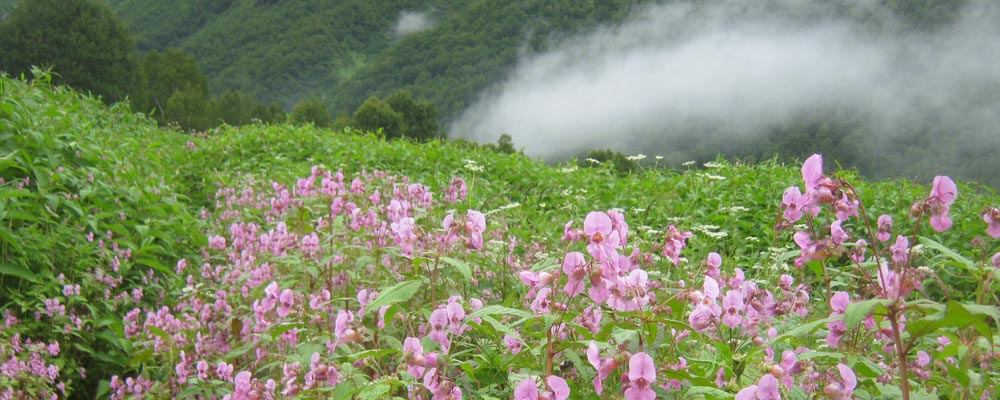
Valley-of-Flowers
"Serene valley of Flowers"
Valley of flowers, discovered in 1931 is a World Heritage Site for its wild untamed blooms surrounded by white peaks.
At the meeting point of the Himalayan ranges, Zanskar and Western and Eastern Himalayas, the valley of flowers discovered by Mountaineer Frank S Smith in 1931 has been declared a world heritage site for its wild untamed blooms surrounded by white peaks. Famous for its exotic varieties of medicinal herbs, it is also believed that Hanuman brought Sanjivani to the ailing Lakshmana from the valley of flowers. A perfect place to laze around the umpteen number of Himalayan water-falls, streams and paddocks and let the beauty of the place sink in.
How to Reach Valley of Flowers
By Flight
There is no direct flight connectivity to the Valley of Flowers. Jolly Grant Airport in Dehradun is the nearest commercial airport. You can hire a cab from the airport which will take you directly to Valley of Flowers.
By Road
There is no direct road connectivity to the Valley of Flowers. Buses ply through well connected, motorable roads to Govindghat, the nearest bus stop, approximately 12 km away from the actual site.
By Train
There is no direct rail connectivity to the Valley of Flowers. Rishikesh is the nearest railway station to the same, 272 km away from the Valley. Regular buses ply between Rishikesh and Valley of Flowers. Alternatively, you can also take a taxi from Rishikesh.
Commuting Within Valley of Flowers
Walking is the only option here.
Best Time to Visit Valley of Flowers
Summer (March - June): This is not exactly the most advisable time for a visit to the Valley. The snow starts melting, and the flowers don't even bloom at this time. However, being the off-season, you can go for a trek to the adjoining trekking hotspots.
Monsoon (July - September): This is the best time for a visit to the Valley. The flowers are fully bloomed by now, and the snow has also completely melted away. The climate is also pleasant during these months.
Winter (October - February): Beginning from October, the winter season is the least advisable time for a visit to the same. The snow starts falling, and the valley becomes unbearably cold.
Food and Cuisine of Valley of Flowers
The area does not offer many choices in food and hence it is best to pack some food for your trip here or make personal arrangements. Some hotels and lodges nearby might serve typical Indian food.
places to visit in Valley of Flowers
Hemkund Sahib
Nestled amid the Himalayan Ranges, Sri Hemkunt Sahib is a sacred pilgrimage revered by thousands of Sikhs every year. Adorned with beautiful scenic view, the holy place offers tranquility at such an altitude.
Perched at an altitude of 4329 m above the sea level, Hemkunt Sahib is regarded as one of the holiest places for Sikhs. Literally meaning 'Lake of Snow', the crystal clear water of the lake is equally cold as snow. Also known as Gurudwara Shri Hemkunt Sahib, it can be reached by trekking through numerous waterfalls, thick forest and captivating views of the Himalayas.
The gurudwara is open only for few months and close down during the extreme winter months. Visited by a myriad of devotees from all around the globe, it accounts for the highest gurudwara of the Sikh community.
Valley of Flowers National Park
A World Heritage Site, Valley of Flowers is probably one of the most beautiful places on Earth. The spread of colourful flowers against the snow-capped mountains during spring is a must-see.
You should also laze around the umpteen number of himalayan water-falls, streams and paddocks for the beauty of the place to sink in. Reaching Valley of Flowers from Joshimath is also a nice experience. As one nears Gangaria (which is roughly 3 km from the valley), the perfumes of the flowers start coming and visitors are mesmerized by the experience. The vistors need to take a permit from Gangaria to enter Valley of Flowers. The permit is for 3 days and one can trek only during daytime. Visitors are not allowed to stay in the valley during the night and hence accommodation has to be takenin Gangaria itself.
Nanda Devi National Park
Himalayan snow leopard is the major attraction of Nanda Devi National park amidst the valley of flowers and mountain ranges. Other animals found here are the endangered Asiatic black bear, blue sheep, and brown bear.
It is also popular for its medicinal plants and herbs. Nanda Devi peak, which is one of the highest peaks of the world can be seen very closely from this National Park. Along with Valley of Flowers, Nanda Devi National Park has been declared as World Heritage Sight.
Fauna & Flora
This area is home to several rare and endangered species including the Snow leopard, Asiatic black bear, musk deer, flying squirrel, tahr, brown bear, red fox and blue sheep.
However, the density of animals is very low. Among the birds, Himalayan Monal Pheasant and other high altitude birds can be sighted in this National Park. Among flowers, orchids, poppies, primulas, marigold, daisies and anemones are very abundant. However, there are more than 500 species of higher plants in this area. Some of these plants also have medicinal values.


